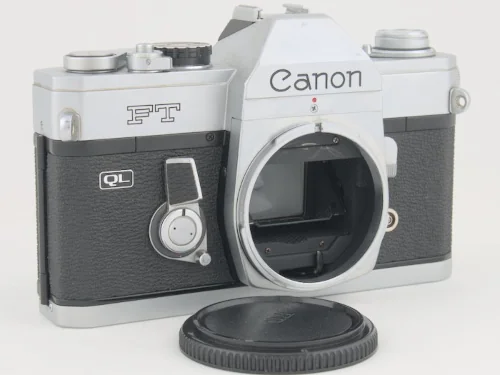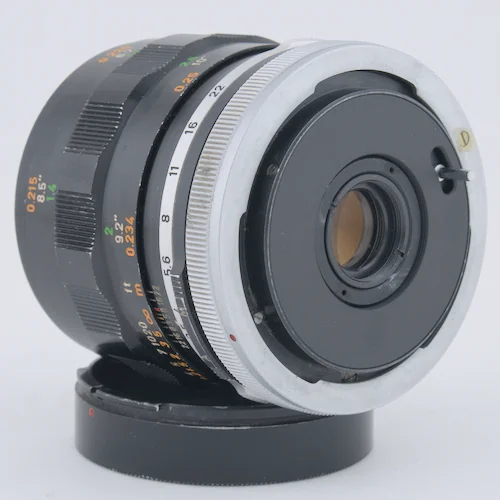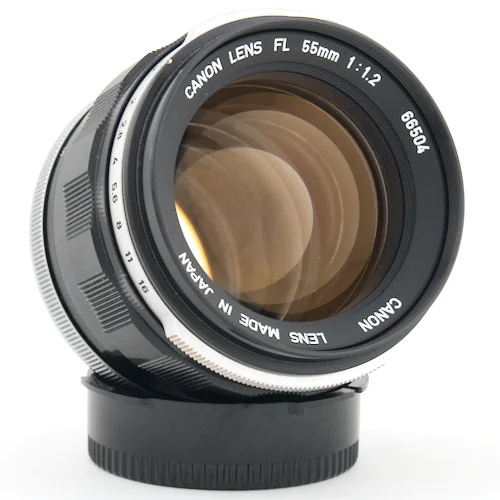Canon FL Mount - 35mm Film SLR Breech Lock

The Canon FL lens mount replaced the Canon R lens mount in 1964 with the release of the Canon FX camera. The FL mount would be used until 1971 when it was replaced by the compatible Canon FD lens mount.
The Canon R mount is similar to the FL and FD mounts, but the aperture control mechanism is different, even though the lenses will mount onto the FL or FD mounts. That does mean the R mount lenses will work with the same adapters that will allow you to use a FL lens on a modern mirrorless camera.
The Canon Camera Museum has a information on all the FL lenses that were made by Canon. That list was used as a reference for the table below.
There were also some FL mount lenses that were made by third parties. Tamron made an Adaptall lens adapter that will allow Adaptall lenses to be used on Canon FL camera bodies.
Canon FL Lens Mount Technical Specs
Sure, let’s make a comparison table about the flange focal distance and mount diameter of Canon’s FL, FD, EOS (EF), and RF mounts.
| Lens Mount | Flange Focal Distance | Mount Diameter |
|---|---|---|
| Canon FL | 42.00 mm | 48.00 mm |
| Canon FD | 42.00 mm | 48.00 mm |
| Canon EOS (EF) | 44.00 mm | 54.00 mm |
| Canon RF | 20.00 mm | 54.00 mm |
Sure, here are brief descriptions of the flange focal distance and mount diameter:
Flange Focal Distance
The flange focal distance, often also referred to as the flange distance or register distance, is the distance from the mounting flange (the metal ring on the camera and the rear of the lens) to the film plane or image sensor.
This distance is critical because it determines which lenses can be used with which cameras - especially important when considering using lenses with adapters. In essence, it’s what makes a lens mount system unique and affects compatibility across different lens and body combinations.
Mount Diameter
The mount diameter is the size of the lens mount, measured as the diameter of the circle formed by the lens mount. This is important because it affects the size of the lens elements that can be used, which in turn can influence the design of the lenses.
A larger mount diameter can allow for lenses with larger apertures, potentially leading to better light-gathering capabilities and image quality. Additionally, a larger mount diameter can also enable more advanced lens designs.
List of Canon FL Mount SLRs
Here is the list of all of the Canon SLR cameras that use the FL lens mount and the year they were released.
- Canon FX (1964)
- Canon FP (1964)
- Canon Pellix (1965)
- Canon FT QL (1966)
- Canon Pellix QL (1966)
- Canon TL (1968)
- Canon FTb QL (1971)
This list does not include the Bell & Howell cameras that were rebranded Canon cameras.
Differences Between the FL and FD Lens Mounts
There are some notable differences between Canon FD/FL lenses.
Canon FL Mount
- Manufacturing period: The FL lens mount was introduced by Canon in April 1964 and was used until 1971.
- Metering: With the FL mount, the aperture must be manually stopped down for metering because it doesn’t provide an automatic aperture linkage.
- Coupling: FL lenses use a breech-lock mount, but there’s no lock pin. Instead, the lens is held in place by friction.
- Compatibility: FL lenses can be mounted on both FL and FD mount cameras, but using them on the latter requires stop-down metering.
- Functionality: FL lenses lack automatic aperture control.
Canon FD Mount
- Manufacturing period: The FD lens mount replaced the FL mount and was produced from 1971 until it was replaced by the EF lens mount in 1987. (It was replaced by the Canon EF Mount.)
- Metering: The FD mount introduced a system of automatic aperture control (open-aperture metering), which was a major advancement over the FL mount.
- Coupling: Early versions of the FD mount also use a breech-lock mechanism, but later versions (the “New FD” or “FDn” series) switched to a simpler twist-locking bayonet style.
- Compatibility: FD lenses can be mounted on FD and New FD cameras, but they are not directly compatible with the later EF mount Canon EOS cameras without the use of an adapter, which generally results in loss of some functionality, such as the ability to focus to infinity.
- Functionality: FD lenses offered more advanced features than the FL lenses, including improved optical quality and automatic aperture control.
Breech Lock Lens Mount Description
The breech-lock mechanism consists of a ring around the lens mount that can be rotated to lock or unlock the lens onto the camera body.
When attaching the lens to the camera body, the lens is first inserted into the lens mount and then the breech-lock ring is rotated to secure the lens in place. This mechanism provides a secure and tight fit for the lens, preventing any unwanted movement or shaking while the camera is in use.
To remove the lens from the camera body, the breech-lock ring is rotated again to unlock the lens, allowing it to be easily removed from the mount.
Breech-lock mechanisms were used in SLR cameras during the 1960s and 1970s, and were popular for their secure attachment and easy removal of lenses.
Other camera mounts that used a breech lock:
- Mamiya RB (Medium Format Film)
- Canon FD (35mm Film)
- Contax G (35mm Film)
- Petriflex (35mm Film)
- Bolix Bajonet (16mm Film)
- Kowa Six/Super 66 (Medium Format Film)
- Pentacon Six (Medium Format Film)
Breech Lock vs Bayonet

The breech-lock and bayonet mount are two common mechanisms used to attach lenses to cameras. Here are some differences between the two:
- Attachment mechanism: In a breech-lock mount, the lens is inserted into the mount and then secured by rotating a ring to lock it in place. In a bayonet mount, the lens is aligned and then twisted into place on the camera body. Bayonet mounts typically provide a quicker and easier attachment process compared to breech-lock mounts.
- Size: Breech-lock mounts tend to be larger than bayonet mounts due to their construction. This can make breech-lock mounts less practical for smaller cameras.
- Security: Both mount types provide a secure attachment for lenses, but the breech-lock mechanism tends to be more secure due to its ability to tightly clamp the lens in place. However, bayonet mounts are typically more durable and resistant to wear and tear over time.
- Compatibility: Breech-lock mounts are usually not interchangeable with other mounts, while bayonet mounts can be designed to fit a variety of camera bodies and lenses. This makes it easier to switch lenses between different camera systems, which can be useful for photographers who use multiple camera brands.
Breech Lock vs M42 Screw Mount
The M42 screw mount was common around the same time the FL was Canon’s current lens mount. The entire lens spins onto a camera body, which can lead to some alignment issues.
List of Canon FL Lenses

There are a total of 33 different Canon FL interchangeable lenses. Each different version of a Canon lens have been counted as unique lenses. This is because the lens formula and/or optical coatings would have been changed.
The image quality is also different with “newer” versions having less spherical aberration, chromatic aberration, and/or barrel distortion. This is noticeable with the standard lenses (50mm, 55mm, and 58mm focal lengths) as they have the most version.
The Canon FL 19mm f/3.5 is a short focus lens. The rear element of the lens goes back into the mirror box and will hit the mirror. As such it can only be used in Canon SLR cameras that have mirror lock-up functionality. (FP, FX, FT, F-1 (old), Ftb, and EF)
The Canon FL P 38mm f/2.8 can only be used on the Pellix and Pellix QL cameras.
The Canon FL M 50mm f/3.5 is a macro lens. In order to reach 1:1 magnification, a 25mm extension tube needs to be used. It does not matter if it is the Canon extension tube, a third party extension tube, or a Canon bellows. Without the adapter the lens is still useful for close-up photography.
The Canon FL M 100mm f/4 is a bellows lens. It does not have a focusing ring. Focusing is meant to be controlled by mounting the lens onto a bellows instead of directly onto a Canon SLR.
The Canon FL-F 300mm f/5.6 and 500mm f/5.6 are notable because they have flourite lens elements.
Complete List of Canon FL Mount Lenses
| Lens Name | Minimum Aperture | Lens Elements | Lens Groups | Aperture Blades | Close Focus (m) | Filter Thread (mm) | Diameter (mm) | Length (mm) | Weight (g) | Released |
|---|---|---|---|---|---|---|---|---|---|---|
| FL 19mm f/3.5 | 16 | 9 | 7 | 6 | 0.5 | 58 | 65 | 18 | 150 | August 1964 |
| FL 19mm f/3.5R | 16 | 11 | 9 | 6 | 0.5 | Series IX | 82 | 68 | 500 | November 1965 |
| FL 28mm f/3.5 | 16 | 7 | 7 | 6 | 0.4 | 58 | 65 | 40 | 240 | December 1966 |
| FL 35mm f/2.5 | 16 | 7 | 5 | 6 | 0.4 | 58 | 63 | 55 | 352 | March 1964 |
| FL 35mm f/3.5 | 16 | 6 | 6 | 6 | 0.4 | 48 | 62 | 43 | 270 | May 1968 |
| FL P 38mm f/2.8 | 16 | 4 | 3 | 6 | 0.8 | 48 | 66 | 21 | 210 | May 1965 |
| FL 50mm f/1.8 I | 16 | 6 | 4 | 6 | 0.6 | 48 | 61 | 40 | 228 | March 1964 |
| FL 50mm f/1.8 II | 16 | 6 | 4 | 6 | 0.6 | 48 | 62 | 42.5 | 280 | March 1968 |
| FL 50mm f/1.4 | 16 | 6 | 4 | 8 | 0.6 | 58 | 65 | 43 | 280 | April 1965 |
| FL 50mm f/1.4 I | 16 | 6 | 5 | 8 | 0.6 | 58 | 64 | 43 | — | September 1966 |
| FL 50mm f/1.4 II | 16 | 7 | 6 | 8 | 0.6 | 58 | 65 | 51 | 340 | May 1968 |
| FL M 50mm f/3.5 | 22 | 4 | 3 | 6 | 0.234 | 58 | 64 | 56 | 295 | June 1965 |
| FL 55mm f/1.2 | 16 | 7 | 5 | 8 | 0.6 | 58 | 67 | 52.5 | 480 | July 1968 |
| FL 58mm f/1.2 (I) | 16 | 7 | 5 | 8 | 0.6 | 58 | 64.5 | 52.5 | 410 | March 1964 |
| FL 58mm f/1.2 (II) | 16 | 7 | 5 | 8 | 0.6 | 58 | 64.5 | 52.5 | 410 | March 1966 |
| FL 85mm f/1.8 | 16 | 5 | 4 | 8 | 1 | 58 | 64 | 55 | 445 | September 1964 |
| FL 100mm f/3.5 | 22 | 5 | 4 | 6 | 1 | 48 | 63 | 61 | 278 | October 1964 |
| FL M 100mm f/4 | 22 | 5 | 3 | 8 | — | 48 | 61 | 43 | 220 | September 1969 |
| FL 135mm f/2.5 | 16 | 6 | 4 | 8 | 1.5 | 58 | 68 | 102 | 645 | May 1965 |
| FL 135mm f/3.5 | 22 | 4 | 3 | 8 | 1.5 | 48 | 62 | 83 | 434 | September 1966 |
| FL 200mm f/3.5 (I) | 22 | 7 | 5 | 8 | 2.5 | 58 | 68 | 152.5 | 660 | March 1964 |
| FL 200mm f/3.5 (II) | 22 | 7 | 5 | 8 | 2.5 | 58 | 68 | 152.5 | 680 | May 1966 |
| FL 300mm f/2.8 S.S.C. Fluorite | 32 | 6 | 5 | 12 | 3.5 | — | 112 | 230 | 2340 | February 1974 |
| FL-F 300mm f/5.6 | 22 | 7 | 6 | 8 | 3.5 | 58 | 75 | 168 | 850 | May 1969 |
| FL 400mm f/5.6 | 32 | 5 | 4 | 8 | 4.5 | 48 | 108 | 338 | 3890 | September 1971 |
| FL-F 500mm f/5.6 | 22 | 6 | 5 | 6 | 10 | 95 | 106 | 300 | 2700 | June 1969 |
| FL 600mm f/5.6 | 32 | 6 | 5 | 8 | 10 | 48 | 128 | 448 | 5000 | September 1971 |
| FL 800mm f/8 | 32 | 7 | 5 | 8 | 18 | 48 | 128 | 508 | 5360 | September 1971 |
| FL 1200mm f/11 | 64 | 7 | 5 | 8 | 40 | 48 | 128 | 853 | 6200 | June 1972 |
| FL 55-135mm f/3.5 | 22 | 13 | 10 | 8 | 2 | 58 | 69 | 140 | 780 | March 1964 |
| FL 85-300mm f/5 | 22 | 15 | 9 | 6 | 4 | 72 | 93 | 279 | 1850 | April 1965 |
| FL 100-200mm f/5.6 | 22 | 8 | 5 | 8 | 2.5 | 55 | 64 | 173 | 650 | December 1966 |
The maximum aperture for each lens is included with the name and focal length.